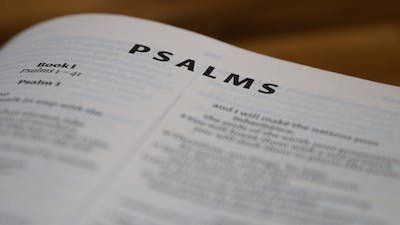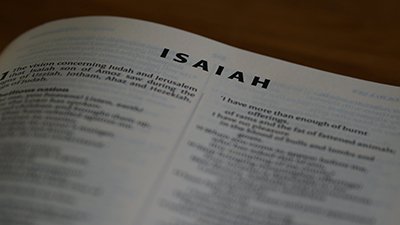Jesus’ Genealogies in Matthew and Luke
Why does Jesus have two different genealogies?
At Christmas, we celebrate Jesus’ birth. Church Christmas plays focus on the nativity and the visit of the wise men, but the two Gospel writers who include details about Jesus’ birth and infancy also tie the account of Jesus’ birth to the Old Testament with a genealogy. Matthew emphasizes Jesus’ royal lineage, tracing his ancestry through David back to Abraham, while Luke emphasizes his common humanity by going all the way back to Adam.
A Contradiction?
Anyone who studies the genealogies will immediately notice that the genealogies are stated to be of Joseph, not Jesus. Matthew 1:16 reads, “and Jacob the father of Joseph the husband of Mary, of whom Jesus was born, who is called Christ,” while Luke 3:23 reads, “Jesus, when he began his ministry, was about thirty years of age, being the son (as was supposed) of Joseph, the son of Heli.” Both genealogies clearly state Joseph as the last link of the genealogy, with some separation showing that Joseph was not the biological father of Jesus.
But Matthew and Luke seem to disagree about who Joseph’s father was—was Joseph the son of Jacob or Heli? In fact, Matthew’s and Luke’s genealogies split at David, listing Joseph as descended from two different sons of David, with completely different lines of ancestry.
There are a number of ways people have explained this, starting very early in church history. For instance, John Gill, writing in the 1700s, said, “It is true indeed that Joseph was the son of Eli, having married his daughter; Mary was the daughter of Eli, and so the Jews speak of one Mary, the daughter of Eli, by whom they seem to design the mother of our Lord.”1
One solution that seems very likely is that Luke is actually relating Mary’s genealogy, and thus, is showing how Jesus is biologically linked to Adam. If Mary’s parents had no sons, Joseph could have been reckoned as their adopted son.
These adoptive relationships were every bit as real as biological relationships. For instance, before Abraham had a biological heir, he planned to leave his property to Eliezer of Damascus. And a few generations later, Jacob adopted his grandchildren Ephraim and Manasseh as a way to give Joseph a double portion of inheritance. This is important, because Jesus is qualified to be David’s heir because his adopted father, Joseph, was the next in line. Jesus, when he began his ministry some time after Joseph’s death, was the heir apparent, even though Joseph went on to have biological sons with Mary.
So, a possible explanation for Joseph’s two genealogies is that Matthew’s genealogy reflects Joseph’s biological lineage, which makes Jesus by adoption the heir apparent, while Luke’s lineage is Mary’s biological lineage (but is stated to be Joseph’s through an adoptive process because Mary’s parents had no sons). Because adoptive lineages are as real as biological ones, and because lineage is counted through the father’s line, not the mother’s, both legal genealogies of Joseph become the legal genealogies of Jesus. Though Jesus had no biological father, as he was conceived miraculously through the Holy Spirit overshadowing Mary when she was a virgin, the Bible treats Joseph as the real father of Jesus by adoption.
How Many Generations?
Matthew 1:17 says, “So all the generations from Abraham to David were fourteen generations, and from David to the deportation to Babylon fourteen generations, and from the deportation to Babylon to the Christ fourteen generations.” But if you compare Matthew’s genealogy to the actual list of kings in the Old Testament, there are some omissions.
The kings Ahaziah, Joash, and Amaziah have been deleted between Joram and Uzziah. Carson notes that they may have been omitted because they were particularly wicked and were connected with Ahab and Jezebel. “Two of the three were notoriously evil; all three died violently.”2 Also, Jehoiakim was deleted between Josiah and Jehoiachin.
There are also not precisely 14 generations in each of Matthew’s groupings. If one counts Abraham, there are fourteen generations from Abraham to David. Then there are fourteen generations between Solomon and Jeconiah. But there are only thirteen generations between Shealtiel and Jesus. Creating three groups of fourteen requires counting someone twice. There are a couple possible ways to resolve this: see “Problems With Basic Math?” for one possible solution. Carson suggests this explanation:
The simplest explanation—the one that best fits the context—observes that the numerical value of “David” in Hebrew is fourteen. By this symbolism Matthew points out that the promised “son of David” (1:1), the Messiah, has come. And if the third set of fourteen is short one member, perhaps it will suggest to some readers that just as God cuts short the time of distress for the sake of his elect (24:22), so also he mercifully shortens the time from the Exile to Jesus the Messiah.”3
Is it a problem that Matthew omitted names, for whatever reason, from his genealogy? Genealogies exist in Scripture for multiple reasons, and it is important to examine what a given genealogy means to do in a certain situation. Matthew’s genealogy exists to trace the kingly line of David to Jesus through his adoptive father, Joseph. The genealogy would have been valid to his Jewish audience, or there would have been no point in including it. The point of Matthew’s genealogy is to show how Jesus is descended from Abraham and David, and it succeeds.
Does it imply that there may be missing generations elsewhere in biblical genealogies? Some genealogies primarily connect a person to his tribe through his immediate ancestors—it does not matter if there are missing generations in such cases. The genealogy may be true even if it is not exhaustive. Other genealogies stress the strict father-to-son progression of generations, such as the Genesis genealogies that even include chronological information and leave no room for missing generations.
Was Jesus the Biological Descendant of King David Through Mary?
One of the most common Messianic titles for Jesus was “Son of David,” but was he? Since there is no explicit biblical statement that Luke’s genealogy is Mary’s lineage, is there a way to tell whether Mary was also from the house of David?
Multiple biblical statements seem to confirm that Mary was a descendant of King David. When the angel Gabriel announced that Mary would bear the Son of God, Gabriel said, “And the Lord God will give to him the throne of his father David” (Luke 1:32). This suggests that Jesus will be the biological descendant, not just a legal descendant through adoption. Romans 1:3 also says that Jesus “was descended from David according to the flesh.”
If, as suggested above, Luke’s genealogy records Mary’s lineage, there is an explanation that would make sense of the biblical data. One adoptive relationship could occur when a couple had a daughter but no sons. When the daughter married, the son-in-law could be reckoned as an adoptive son for purposes of inheritance. When this happened, the woman also needed to marry someone within her own tribe so that the inheritance would not go from one tribe to another. The Bible doesn’t explicitly say whether this is the case with Mary and Joseph, but it is one possibility. That would mean that Joseph is the son-in-law of Heli, in which case Jesus would be biologically descended from David through his son Nathan and ultimately through Mary, though the line is traced through Joseph.
This is important, because genealogies in Scripture never go through the mother—they’re always patrilineal, going through the father’s line. Inclusion of women in a genealogy at all is unusual. If Joseph had been adopted by Mary’s parents, then there’s an “official” patrilineal way for Jesus’ biological genealogy to be recorded as well as his kingly genealogy.
Son of David, Son of Man
Two of the most common titles for Jesus were “Son of David,” an overtly Messianic title, and his self-description as “Son of Man”—likely a reference to Daniel 7:13. Matthew shows how Jesus is the Son of David—he is in the line of succession to the Davidic crown. Luke shows how he is a “Son of Man”—he is related to all of us through our common forefather, Adam.
There is a treasure trove of biblical history in the genealogies of Jesus. Matthew’s genealogy, going through Joseph’s line, presents Jesus the Son of David, the kingly Messiah who would deliver his people. Luke’s genealogy, going through Mary’s line, presents Jesus, the Last Adam, the Son of God who would succeed where Adam failed and undo the curse of death.
God intervened many times to ensure that Abraham’s Davidic descendants survived until the ultimate Son of David arrived to fulfill God’s promise that David’s descendants would rule forever. As we celebrate Christ’s birth, the genealogies of Matthew and Luke draw us to also celebrate God’s love and provision for his people for thousands of years that prepared the way for Jesus’ birth.
Footnotes
- John Gill, “Luke 3” in Gill’s Exposition of the Whole Bible, https://www.studylight.org/commentaries/eng/geb/luke-3.html.
- D. A. Carson, Matthew, in Expositor’s Bible Commentary vol. 8, ed. F. Gæbelein (Grand Rapids, MI: Zondervan, 1984), 67.
- Carson, Matthew, 69.

Answers in Genesis is an apologetics ministry, dedicated to helping Christians defend their faith and proclaim the good news of Jesus Christ.
- Customer Service 800.778.3390
- © 2024 Answers in Genesis




